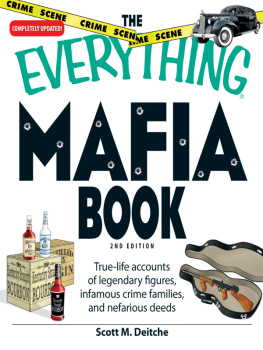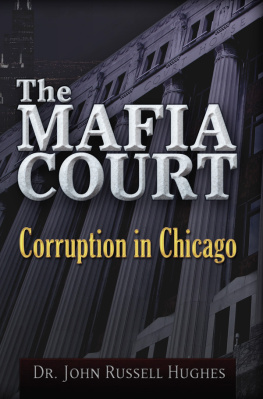MOUNTAIN
MAFIA
Organized Crime in the Rockies
Betty L. Alt
&
Sandra K. Wells
Copyright 2020 by Betty L. Alt & Sandra K. Wells.
Library of Congress Control Number: | 2020912023 |
ISBN: | Hardcover | 978-1-9845-8522-6 |
Softcover | 978-1-9845-8521-9 |
eBook | 978-1-9845-8520-2 |
All rights reserved. No part of this book may be reproduced or transmitted in any form or by any means, electronic or mechanical, including photocopying, recording, or by any information storage and retrieval system, without permission in writing from the copyright owner.
This book is a work of non-fiction. Unless otherwise noted, the author and the publisher make no explicit guarantees as to the accuracy of the information contained in this book and in some cases, names of people and places have been altered to protect their privacy.
Any people depicted in stock imagery provided by Getty Images are models, and such images are being used for illustrative purposes only.
Certain stock imagery Getty Images.
RE-PRINTED 2020
Rev. date: 06/30/2020
Xlibris
1-888-795-4274
www.Xlibris.com
813823
CONTENTS
T he history of the Mafia in the Rocky Mountain region reads like a fascinating story from a true crime magazine. Although there were many individuals involved from the era of the Black Hand, the bootlegging times of Prohibition and into the 1980s, this book cannot present all of their stories. It deals chiefly with the lives of the major players on Colorados organized crime scene.
A great amount of information has appeared in Americas media, especially movies and television, about the Mafia in the eastern part of the nation. Only a few recent books even mention the Colorado mob. This may be understandable when considering that the total population of the state during most of the twentieth century was smaller than that of New York City, Chicago or Philadelphia. However, up and down the front range of the Rockies, the exploits of the Mafia can be traced in the pages of newspapers in Denver, Pueblo, Trinidad, Colorado Springs, etc.
In presenting an overview of the Mafia in Colorado, the authors selected material from hundreds of pages of research and coped with many discrepancies. In both national and local material, they encountered names that were spelled differently, dates that did not mesh, and events that were sometimes distorted. Even in those few books that mention Colorados mafia, sources do not always agree, endnotes often do not match citations, and bibliographies are either incomplete or not furnished at all. Data from national crime commissions contain dates different from Mafia obituaries, and, occasionally, someone has been listed as having been killed when the individual was only wounded or cannot be located.
Because those involved in Colorados organized crime were continually arrested, charged, out on bond, tried, sentenced, pardoned or paroled, it is impossible to include all of the interesting material or to cover all of the illegal activities that took place. (For example, the lengthy NCCD report lists over 240 crimes in Denver attributed to organized crime just during a two-year period in the late 1960s.) Every attempt has been made by the authors to glean and present an accurate summation of organized crime in the Rocky Mountain area for most of the twentieth century. For those wishing to know more details about various individuals and their crimes, trials conducted, and sentence imposed, the book has an extensive bibliography. Also, microfilm in libraries from Denver to Trinidad can provide an endless source of information from Colorado newspapers.
The authors wish to thank the research department at Colorado State University-Pueblo, librarians in Trinidad, Pueblo, Canon City, Colorado Springs and Denver, who were so helpful, those individuals interviewed who provided some highlights on Colorados organized crime figures, and those persons who sent information they had gleaned from various sources. They also thank their families for their help and patience during the completion of this project.

. .. You may stop us from persecuting you as you have been adjudged to give money or life. Woe upon you if you do not resolve to buy your future happiness, which you can do from us by giving the money demanded. Preparati per la tua morte. (Prepare for your d eath.)
Black Hand letter,
The Cosmopolitan, June 1909

S now glistening on the peaks of the Sangre de Cristo mountain range was a beautiful sight; however, it was not the scenery that attracted Italian immigrants to southern Colorado in the late nineteenth and early twentieth centuries. Fertile land along the Arkansas River could be put under irrigation and promised ripe harvests in the otherwise arid climate. Families were able to purchase small farms, and fields of tomatoes, onions and peppers began to dot the countryside to the east of Pueblo.
Still, only a small portion of these early immigrants settled on the land. Coal mine owners in Colorado were begging for men to drop into the earth and haul out its black bounty. Prior to Congress prohibiting in 1885 the importation of foreign workers to work under contract in the United States, representatives from various industries went to Europe to hire cheap labor. ( ) During these times Pueblo was known as the Smelter Capital, Steel City, or Pittsburg of the West. Both its smelters and the Colorado Fuel and Iron Corporation (CF&I) were in need of laborers, and the steel mill advertised overseas and in eastern newspapers for men and families to come west. Many of these settled in Pueblos Italian community known as Smelter Hill or, because some had one or more goats, as Goat Hill. However, goats were not what the steel industry needed, and finding an adequate supply of hands willing to handle dirty, heavy jobs was difficult.
As late as 1907, the local newspaper, The Pueblo Chieftain , advised employers that steamers of the North German Lloyd line would be arriving at Galveston with large numbers of immigrants seeking work. Those needing workers were told to contact an Otto Letzerich in Galveston and let him know the number of men needed, nature of the work and wages. For a small fee Letzerich would contract for the laborers and ticket such as may be secured through to destination, ( ) This service provided by Letzerich was of immense aid both to those seeking employment and to their prospective employers.
Between 1900 and 1910 nearly one and a quarter million Italian immigrants came to the United States from Italy, a large proportion from Sicily. The oppression of landlords, high taxes and poverty in Italy and Sicily were the impetus for this migration. ( ) Although many of these immigrants remained in the eastern section of the United States where they found employment in Americas expanding industries, many who entered in the southern part of the country at ports in New Orleans or Galveston headed north.
Trinidad, Walsenburg and Canon City, along with the small community of Aguilar, became the hub of Colorados coal industry, and the slopes and valleys of the nearby mountains were dotted with mine shafts. Those Italian immigrants who settled along this eastern slope of the Rocky Mountains and labored in the coal mines usually ended up living in company towns erected by the mine owners. Outside of Trinidad, coal camps such as Starkville, Sopris, Berwinds, Majestic, Cedarhurst, Bon Carbo and several others sprang up, and Morley was constructed just north of the New Mexico border on Raton Pass. By the early 1900s in Huerfano County, the coal camps of Pryor, Cameron, Ludlow, Ravenwood, Herzron and Walsen were established outside of Walsenburg. ( )
Next page














